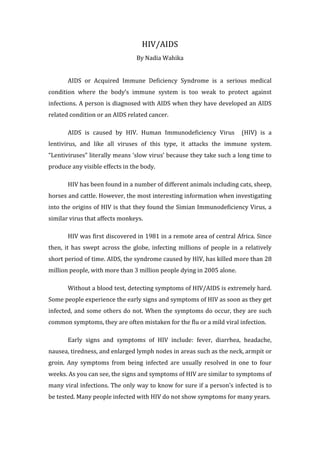
Hiv nadia gr10
- 1. HIV/AIDS<br />By Nadia Wahika<br />AIDS or Acquired Immune Deficiency Syndrome is a serious medical condition where the body’s immune system is too weak to protect against infections. A person is diagnosed with AIDS when they have developed an AIDS related condition or an AIDS related cancer. <br />AIDS is caused by HIV. Human Immunodeficiency Virus (HIV) is a lentivirus, and like all viruses of this type, it attacks the immune system. “Lentiviruses” literally means ‘slow virus’ because they take such a long time to produce any visible effects in the body. <br />HIV has been found in a number of different animals including cats, sheep, horses and cattle. However, the most interesting information when investigating into the origins of HIV is that they found the Simian Immunodeficiency Virus, a similar virus that affects monkeys. <br />HIV was first discovered in 1981 in a remote area of central Africa. Since then, it has swept across the globe, infecting millions of people in a relatively short period of time. AIDS, the syndrome caused by HIV, has killed more than 28 million people, with more than 3 million people dying in 2005 alone. <br />Without a blood test, detecting symptoms of HIV/AIDS is extremely hard. Some people experience the early signs and symptoms of HIV as soon as they get infected, and some others do not. When the symptoms do occur, they are such common symptoms, they are often mistaken for the flu or a mild viral infection. <br />Early signs and symptoms of HIV include: fever, diarrhea, headache, nausea, tiredness, and enlarged lymph nodes in areas such as the neck, armpit or groin. Any symptoms from being infected are usually resolved in one to four weeks. As you can see, the signs and symptoms of HIV are similar to symptoms of many viral infections. The only way to know for sure if a person’s infected is to be tested. Many people infected with HIV do not show symptoms for many years.<br />Only when someone is in later stages of HIV/AIDS the symptoms get a bit more detectable. The Centers for Disease Control (CDC) says the following symptoms may be signs of late-stage HIV infection: rapid weight infection, dry cough, recurring fever or profuse night sweats, profound and unexplained fatigue, swollen lymph glands in the armpits, groin, or neck, diarrhea lasting more than a week, white spots or unusual blemishes on the tongue, in the mouth, or in the throat, pneumonia, red, brown, pink, or purplish blotches on or under the skin or inside the mouth, nose, or eyelids, and memory loss, depression, and other neurological disorders.<br />HIV spreads by intimate contact with an infected person, such as sexual activity and any other sort of situation that allows blood from one person to enter another. A person can carry the virus for many years before the symptoms even show themselves, in those years a promiscuous carrier could’ve infected dozens of people, who can infect other dozens of people. It has become a never-ending loop. A good way to prevent it would be by using condoms during sexual intercourses. It is also highly advisable to not share intravenous drug equipment. <br />An infected mother may also transmit the disease to her unborn child. Women can transmit HIV to their fetuses during pregnancy or birth. Approximately a quarter to a third of all untreated pregnant women infected with HIV will pass their infection to their baby. HIV can also be transmitted through the breast milk of mothers infected with HIV. The risk is greatly reduced in developed countries where alternatives to breast milk are readily available.<br />However, contrary to popular belief, research indicates that HIV is not transmitted through casual contact such as: touching or hugging, sharing household items such as utensils, towels, and bedding; contact with tears or sweat, sharing facilities such as the swimming pool, hot tub, saunas or toilets with HIV infected people; or being in contact with coughs and sneezes of HIV-infected people.<br />The thought of contracting HIV is frightening. The disease is presently incurable, has a high mortality rate, spreads quickly and has no available vaccine to protect against it. When the HIV enters our system it invades the cells in our immune system and reprograms them to become HIV-factories. Slowly, the number of immune cells decreases and AIDS develops. Once AIDS manifests, the body is susceptible to many different infections because the immune system had been so weakened by HIV it can no longer fight back effectively. It is no wonder that fighting HIV/AIDS is one of mankind’s biggest struggles. <br />